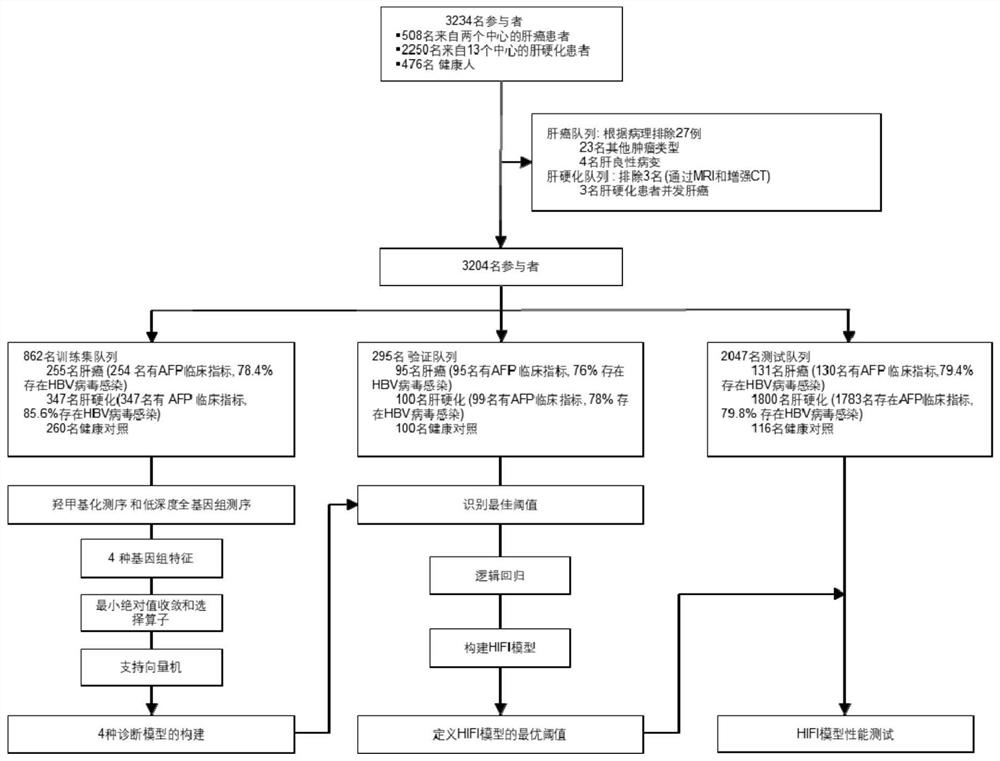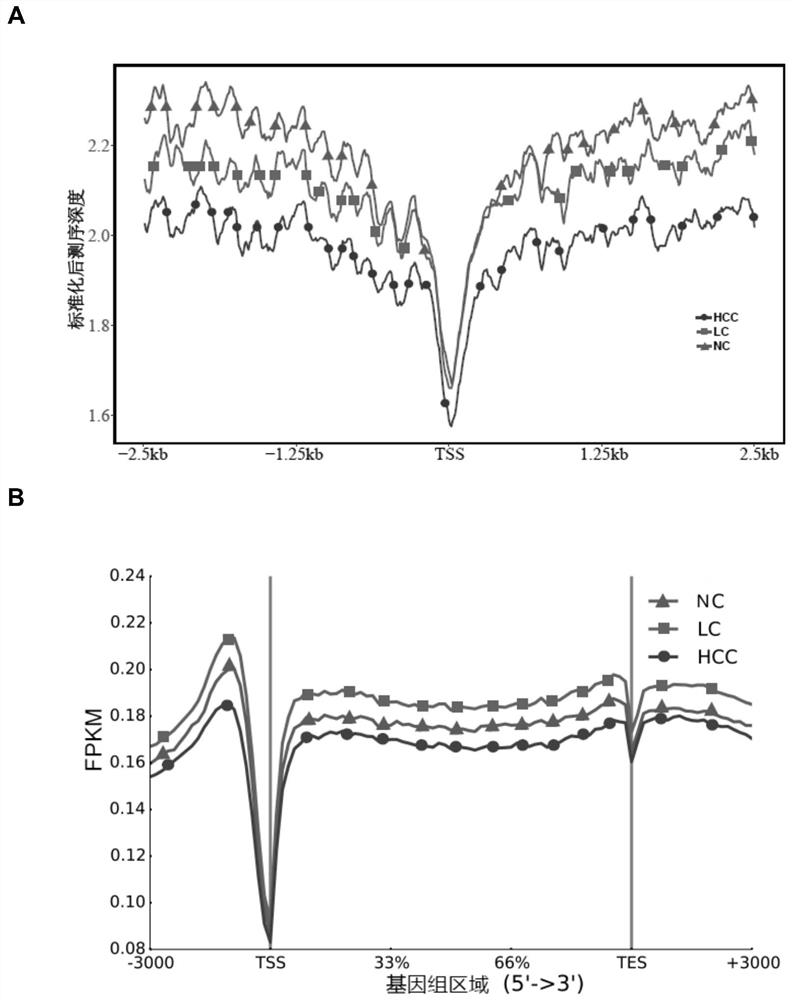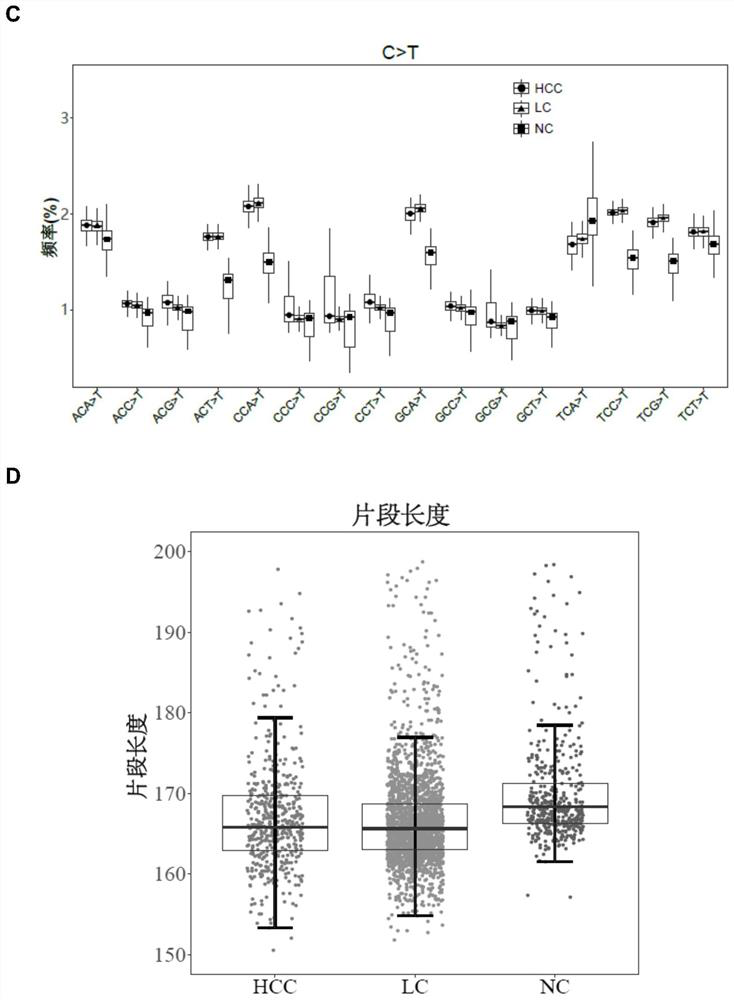Method for constructing tumor screening modeland and application of tumor screening model
A technology for tumor screening and construction methods, applied in the fields of character and pattern recognition, genomics, instruments, etc., which can solve the problems of not being satisfied and not being included in the cohort of early tumor patients
- Summary
- Abstract
- Description
- Claims
- Application Information
AI Technical Summary
Problems solved by technology
Method used
Image
Examples
Embodiment 1
[0058] 3234 participants were recruited, including 508 patients with liver cancer (HCC) from two centers, 2250 patients with liver cirrhosis (LC) from 13 centers, and 476 healthy controls (NC). According to pathological diagnosis, 27 liver cancer samples were excluded, and 3 cases of liver cirrhosis were excluded based on MRI and enhanced CT. The number of finalized participants was 3204 cases ( figure 1 ).
[0059] Take 3ml of peripheral blood from each participant, collect and store it in Streck cell-free DNA blood collection tubes, use Eppendorf centrifuges (5810R and 5427R, German), and centrifuge at a low speed of 1600g for 10min at a low temperature of 4°C, and only take the supernatant ; Then centrifuge at a high speed of 16000g for 10min, and take the supernatant to obtain a plasma sample. The cfDNA in the plasma was then extracted with the kit MagMAX Cell-Free DNA Isolation Kit (Thermo) and a nucleic acid extractor (Thermo Kingfisher FLEX, USA). The concentration o...
Embodiment 2
[0061] 5-Hydroxymethylcytosine sequencing (5hmc-seq) was performed on all participants' cfDNA samples prepared in Example 1. The sequencing process is as follows:
[0062] (1) HomeSeq library construction and on-machine sequencing: Take 5ng cfDNA, mix it with 4pg internal reference DNA mixture (130bp), and use Enzymatics (USA) end repair plus A-tailing kit (5X ER / A-Tailing Enzyme Mix) , and the sequencing linker ligation kit (WGS Ligase) to construct the pre-library, so that the library has a structure that can be sequenced on the Illumina NovaSeq6000 sequencer. After ligation, AMPure XP beads (Beckman) were used for purification, and the library was collected by elution with EB buffer (Qiagen). The pre-library DNA reacted with uridine-6-azide-glucose diphosphate (UDP-6-azide-glucose, Jena Bioscience) under the action of T4 Phageβ-glucosyltransferase (NEB) In the reaction, the azide group of UDP-6-N3-Glc is transferred to 5hmC to form 5gmC-N3 (that is, 5hmC that has been tra...
Embodiment 3
[0065] Low-depth whole-genome sequencing was performed on the cfDNA samples of all participants prepared in Example 1. The sequencing process is as follows:
[0066](1) WGS library construction and on-machine sequencing: Take 5 ng of cfDNA to construct a pre-library with an Enzymatics (USA) related kit, and use the Enzymatics (USA) end repair plus A tail kit (5X ER / A- Tailing Enzyme Mix), the step of adding adapters uses the sequencing adapter ligation kit (WGS Ligase), and the adapter sequence is suitable for the Illumina NovaSeq 6000 sequencing platform. The adapters were ligated and purified using XP magnetic beads (Agencourt AMPure XPbeads, Beckman Coulter). The concentration of WGS library was determined by qPCR (KAPA Library Quant Kit, Roche), and the library size was determined by Fragment Analyzer (Agilent, USA). Afterwards, paired-end 150bp sequencing was performed on the IlluminaNovaSeq 6000 sequencing platform, and the average data volume of a single sample was 2X...
PUM
 Login to View More
Login to View More Abstract
Description
Claims
Application Information
 Login to View More
Login to View More - R&D
- Intellectual Property
- Life Sciences
- Materials
- Tech Scout
- Unparalleled Data Quality
- Higher Quality Content
- 60% Fewer Hallucinations
Browse by: Latest US Patents, China's latest patents, Technical Efficacy Thesaurus, Application Domain, Technology Topic, Popular Technical Reports.
© 2025 PatSnap. All rights reserved.Legal|Privacy policy|Modern Slavery Act Transparency Statement|Sitemap|About US| Contact US: help@patsnap.com



